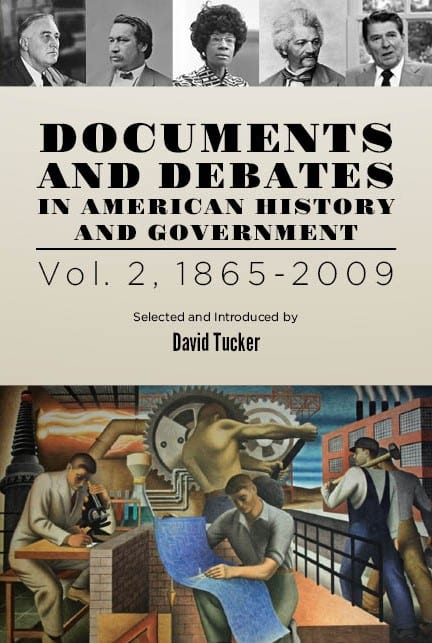Teaching American History’s Documents and Debates volumes presents American history as a series of topics. For each topic, a selection of documents recreates a debate over a particular issue that highlights one of the enduring themes of American life: balancing freedom, equality, liberty and order; the struggle of groups for full inclusion in American life; the role of the government in overseeing the economic life of American citizens; and the ongoing argument over the role America should play in world affairs. Below is a sampling of topics from Documents & Debates, v.2. Each topic contains an introductory essay, a curated and excerpted set of documents, and a series of discussion questions to guide understanding of the topic.
As the Civil War progressed and Union forces gained control of territory in states that had seceded, the question arose as to how that territory and its people – slave and free – should be dealt with. President Lincoln encouraged reconciliation. Other Republicans believed that the South had to be reconstructed in a fundamental way and that the seceding states had to be treated as conquered territories. Meanwhile, the freed men and women sought to construct new lives in extraordinarily difficult circumstances. The long-term effects of Reconstruction – or its failure – are evident in later defenses of the system of segregation developed in the South after Reconstruction.
Documents include Lincoln’s Second Inaugural, Douglass’ “Reconstruction,” and Tillman’s Speech in the Senate.
A recession in 1893 led the Pullman Sleeping Car Company to reduce the wages of its workers, which led to a contentious strike, a boycott of any train containing a Pullman car, and the eventual disruption of the US mail service. A federal court issued an injunction barring the union from hindering railroad traffic. It was upheld by the Supreme Court.
Documents include the US Strike Commission’s “Report on the Chicago Strike,” Harper’s Weekly cartoon, “King Debs,” and Brewer’s opinion in In re Debs.
For almost thirty years, from around 1900 to the late 1920s, America had an active and popular eugenics movement. Beginning with Connecticut in 1896, states passed laws requiring medical exams before issuing marriage licenses to make sure the unfit did not reproduce. Indiana passed the first compulsory sterilization law in 1907, although other states had tried and failed before. Prominent Americans – among them Theodore Roosevelt, Stanford University President David Starr Jordan, W. E. B. Du Bois, and Margaret Sanger – supported the eugenics movement. State Fairs included Better Baby contests. Eugenics was considered a progressive reform, related to the larger Progressive movement by its emphasis on the good of society and the use of science and rationality to achieve it. Sterilization was the most contentious part of the eugenics program, but it remained alive in part because of the Supreme Court decision Buck v. Bell, which found constitutional the sterilization of Carrie Buck by the State of Virginia.
Documents include Pennypacker’s Veto of Eugenics Law, Hall’s “Eugenics as a New Creed,” and Holmes’ opinion in Buck v. Bell.

By 1928, the United States had enjoyed eight years of unprecedented prosperity under Republican Presidents Harding and Coolidge. As the 1928 presidential race drew to a close, the Republican candidate, former Secretary of Commerce Herbert Hoover outlined the Republicans’ governing philosophy, which he credited with producing the prosperity. Seven months after Hoover took office, in October 1929, the stock market crashed. After two weeks, it recovered somewhat, but then began a long-term decline, as the American economy fell into what became known as the Great Depression.
Hoover responded to the economic difficulties according to the principles he had articulated in 1928. The American system was sound, he thought, and would recover with only limited assistance from the government. Franklin Delano Roosevelt, the leading Democratic candidate for President in 1932, argued that the American system as championed by Hoover was not sound and needed to be changed. This was the “New Deal” that Roosevelt offered the American people.
Documents include Hoover’s Principles and Ideals of United States Government, Roosevelt’s “The Forgotten Man,” and Milligan’s Speech on the Smoot-Hawley Tariff.
Allies during the Second World War, the United States and the Soviet Union fell out quickly once it ended. In February 1946, George Kennan, the Chargé at the American Embassy in Moscow, sent a telegram that explained Soviet actions. Quickly dubbed the “Long Telegram,” its analysis and recommendations became the basis for the policy of containment that guided America’s actions toward the Soviet Union until the end of the Cold War. As the Cold War continued, it became a struggle not just between two political and military powers but between two ways of life or which of the two could better meet human needs. Even the quality of American and Soviet kitchens and what that represented could be part of the debate.
Documents include Kennan’s “Long Telegram” and Truman’s “Address (The Truman Doctrine).”
As the United States struggled with the issue of civil rights, another issue of rights began to gain attention: equal rights or equal opportunities for women. As with African American civil rights, the movement for women’s rights had been part of American politics since the Revolution. It too gained momentum following the Civil War; one accomplishment was the Nineteenth Amendment (1920), which guaranteed women the right to vote.Advocates for women’s rights also proposed an amendment guaranteeing equality of rights for women. First introduced in Congress in 1923, the amendment was introduced every year thereafter and passed and submitted to the states finally in 1972, with a deadline for ratification of March 22, 1979.
Thirty-five of the necessary 38 states ratified the amendment before opposition to it, led largely by Phyllis Schlafly, stalled the process. Under pressure, Congress extended the ratification deadline, but the amendment never passed.
Documents include Chisholm’s Address to the House of Representatives, Ginsburg’s “The Need for the Equal Rights Amendment,” and “Dialogue with Phyllis Schlafly on the ERA.”

The end of the Cold War ushered in a new era in international relations and raised the question of how the United States should deal with the post-Cold War world. Like his immediate predecessors, President George W. Bush argued that the United States should promote democracy for America’s sake and for the benefit of the world. This included a global struggle against the people and ideas that sponsored the attacks on the United States on September 11, 2001.
Documents Include: Bush’s Inaugural Address, Obama’s “Address at Cairo University,” and Paul’s “Containment and Radical Islam.”
Download your free pdf today!


